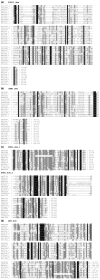Novel G-protein-coupled receptor-like proteins in the plant pathogenic fungus Magnaporthe grisea
- PMID: 15774025
- PMCID: PMC1088943
- DOI: 10.1186/gb-2005-6-3-r24
Novel G-protein-coupled receptor-like proteins in the plant pathogenic fungus Magnaporthe grisea
Abstract
Background: The G-protein-coupled receptors (GPCRs) are one of the largest protein families in human and other animal genomes, but no more than 10 GPCRs have been characterized in fungi. Do fungi contain only this handful or are there more receptors to be discovered? We asked this question using the recently sequenced genome of the fungal plant pathogen Magnaporthe grisea.
Results: Proteins with significant similarity to fungus-specific and other eukaryotic GPCRs were identified in M. grisea. These included homologs of known fungal GPCRs, the cAMP receptors from Dictyostelium, and a steroid receptor mPR. We also identified a novel class of receptors typified by PTH11, a cell-surface integral membrane protein required for pathogenicity. PTH11 has seven transmembrane regions and an amino-terminal extracellular cysteine-rich EGF-like domain (CFEM domain), a characteristic also seen in human GPCRs. Sixty-one PTH11-related proteins were identified in M. grisea that shared a common domain with homologs in Neurospora crassa and other fungi belonging to this subphylum of the Ascomycota (the Pezizomycotina). None was detected in other fungal groups (Basidiomycota or other Ascomycota subphyla, including yeasts) or any other eukaryote. The subclass of PTH11 containing the CFEM domain is highly represented in M. grisea.
Conclusion: In M. grisea we identified homologs of known GPCRs and a novel class of GPCR-like receptors specific to filamentous ascomycetes. A member of this new class, PTH11, is required for pathogenesis, thus suggesting roles in pathogenicity for other members. The identified classes constitute the largest number of GPCR-like proteins reported in fungi to date.
Figures



Similar articles
-
Genome-wide comparative analysis of putative Pth11-related G protein-coupled receptors in fungi belonging to Pezizomycotina.BMC Microbiol. 2017 Jul 25;17(1):166. doi: 10.1186/s12866-017-1076-5. BMC Microbiol. 2017. PMID: 28743231 Free PMC article.
-
Genome-wide prediction of G protein-coupled receptors in Verticillium spp.Fungal Biol. 2010 Apr;114(4):359-68. doi: 10.1016/j.funbio.2010.02.008. Epub 2010 Mar 6. Fungal Biol. 2010. PMID: 20943146
-
Global Analysis of Predicted G Protein-Coupled Receptor Genes in the Filamentous Fungus, Neurospora crassa.G3 (Bethesda). 2015 Oct 13;5(12):2729-43. doi: 10.1534/g3.115.020974. G3 (Bethesda). 2015. PMID: 26464358 Free PMC article.
-
Sensing and transduction of nutritional and chemical signals in filamentous fungi: Impact on cell development and secondary metabolites biosynthesis.Biotechnol Adv. 2019 Nov 1;37(6):107392. doi: 10.1016/j.biotechadv.2019.04.014. Epub 2019 Apr 26. Biotechnol Adv. 2019. PMID: 31034961 Review.
-
Sensing host and environmental cues by fungal GPCRs.Curr Opin Plant Biol. 2024 Dec;82:102667. doi: 10.1016/j.pbi.2024.102667. Epub 2024 Nov 19. Curr Opin Plant Biol. 2024. PMID: 39566322 Review.
Cited by
-
Comparative genomics reveals the origin of fungal hyphae and multicellularity.Nat Commun. 2019 Sep 9;10(1):4080. doi: 10.1038/s41467-019-12085-w. Nat Commun. 2019. PMID: 31501435 Free PMC article.
-
Genome Studies on Nematophagous and Entomogenous Fungi in China.J Fungi (Basel). 2016 Feb 5;2(1):9. doi: 10.3390/jof2010009. J Fungi (Basel). 2016. PMID: 29376926 Free PMC article. Review.
-
Drechslerella stenobrocha genome illustrates the mechanism of constricting rings and the origin of nematode predation in fungi.BMC Genomics. 2014 Feb 8;15:114. doi: 10.1186/1471-2164-15-114. BMC Genomics. 2014. PMID: 24507587 Free PMC article.
-
Differential Expression of Genes Involved in Host Recognition, Attachment, and Degradation in the Mycoparasite Tolypocladium ophioglossoides.G3 (Bethesda). 2016 Jan 22;6(3):731-41. doi: 10.1534/g3.116.027045. G3 (Bethesda). 2016. PMID: 26801645 Free PMC article.
-
CgCFEM1 Is Required for the Full Virulence of Colletotrichum gloeosporioides.Int J Mol Sci. 2024 Mar 2;25(5):2937. doi: 10.3390/ijms25052937. Int J Mol Sci. 2024. PMID: 38474183 Free PMC article.
References
Publication types
MeSH terms
Substances
LinkOut - more resources
Full Text Sources

